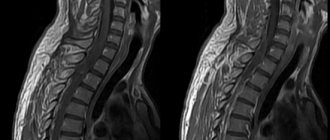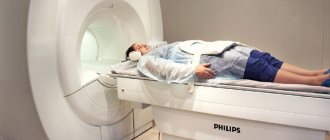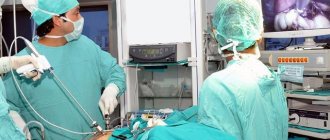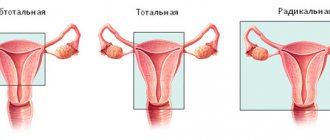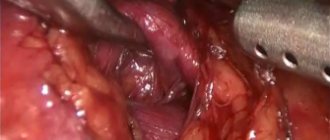Author of the material At the Center for Endovascular Surgery, Prof. Kapranov undergoes operations to remove uterine fibroids. Interventions are carried out by experienced specialists. Professionals always take into account the patient’s health status and strive to ensure that after the operation she can recover as quickly as possible, return to her normal life, and, if desired, carry and give birth to a healthy child.
Are you planning to agree to an operation that is performed surgically rather than endovascularly? Carefully weigh all its pros and cons. Be sure to consult with several specialists. Please also familiarize yourself with the information we provide to you.
Features of the recovery period after surgery to remove uterine fibroids
After surgery to remove myomatous nodes, you will have a long recovery. This is due to the fact that the intervention is often abdominal, affects healthy tissue, and is performed under general anesthesia. The patient is in the hospital for several days. At the same time, she is recommended to rest in bed. Meals after removal of uterine fibroids are provided in the ward.
The woman spends the first few hours after removal of the formation in the intensive care unit. This allows you to monitor her condition and prescribe the necessary medications.
After surgery for uterine fibroids, rehabilitation can last several months. The situation will worsen if during the intervention not only the fibroids are removed, but also the uterus itself. In this case, the recovery period may drag on for years. Moreover, the woman will have to take special medications, regularly visit the doctor, constantly monitor her health, and suffer from a number of symptoms.
Important! Even after abdominal surgery, which was performed successfully, various complications may develop:
- wound infection,
- breathing problems and other consequences of general anesthesia,
- damage to great vessels, abdominal organs, etc.
In addition, after the intervention, the risk of coronary heart disease and breast cancer increases. In some cases, uterine fibroids develop again.
Request a call back Get a free consultation
How is abdominal surgery performed?
Depending on the type of operation, surgical intervention can occur through punctures in the peritoneum, through a longitudinal or transverse incision of the peritoneum, and without incisions, through the vagina.
As already noted, abdominal laparotomy operations are gradually becoming a thing of the past and are used only in special cases. Increasingly, laparoscopic types of operations are used in surgical practice, which reduce intervention to a minimum. Consequently, the risk of complications is sharply reduced, and the patient can return home on the same day, and after 2-3 days lead a normal lifestyle, albeit with restrictions.
During laparoscopic surgery, endovideo equipment is used, which is inserted into the abdominal cavity through a small incision and with the help of which the operation is monitored. To improve visibility, the abdominal cavity is pumped with carbon dioxide. This lifts the abdominal wall and allows the surgeon to manipulate the affected organ through additional punctures. To reduce pain, instruments for abdominal operations are used quite thin, up to several millimeters in diameter.
Preparation for laparoscopic surgery is the same as for laparotomy. It is necessary to answer the doctor’s questions regarding medications and allergies, and talk about concomitant diseases that may affect the operation. Long before surgery, you need to stick to a diet, limiting foods rich in fiber, so as not to provoke bloating, and avoid eating heavy, fried and spicy foods. Before the operation itself, 12 hours before, do not eat or drink anything. In order not to worry, it is better to ask the doctor in advance how abdominal surgery is performed and what you need to take with you.
How is the recovery period after completion of fibroid therapy using UAE?
UAE (uterine artery embolization) is a minimally invasive operation. After it, patients are allowed to leave the walls of the medical institution the very next day after the intervention.
Additionally, a number of drugs are prescribed. They allow you to relieve pain and prevent the occurrence of certain complications. Discomfort after intervention on uterine fibroids completely disappears within 2-3 days. After a few weeks, the patient visits a doctor. This helps prevent the development of possible inflammation and infections.
In the postoperative period, vaginal discharge may occur. This is due to the fact that the remnants of fibroid nodes in some cases come out through the vagina. No special treatment is prescribed during the operation.
Important! UAE is an operation that allows not only to treat fibroids, but also to reduce the risk of severe bleeding, urinary incontinence, and an increase in abdominal size. After 5 years, 90% of patients have no change in their health status. Symptoms of fibroids do not recur.
The menstrual cycle is restored after 2-6 months. Patients over 45 years of age may begin menopause. This is due to the division of blood flow through the arteries of the uterus and ovaries.
Embolization of the uterine arteries is rightfully considered one of the safest procedures in medicine. It is characterized by a lower incidence of complications than with surgery.
All complications that arise can be divided into 3 groups:
- True. They do occur during UAE surgery.
- Invented. Usually opponents of the operation talk about them.
- Previously encountered. Such complications of the operation are not currently recorded. This is due to the fact that measures have been developed to prevent them. There are no problems with the functioning of the uterus.
Important! Abdominal surgery is more dangerous. After completion of complex abdominal surgery to eliminate fibroids, complications are more common. In addition, recovery after the intervention takes a long time. In this case, fibroids may appear again.
Let's consider the main complications that usually frighten patients who decide to undergo surgery to remove fibroids using UAE.
Negative effects of X-ray radiation. Some people claim that surgery can lead to cancer and other diseases. In fact, during the operation (removal of the formation), a special type of X-ray radiation is used. It is softer. In addition, the total radiation time rarely exceeds 2-3 minutes. In fact, such an effect can be compared to one x-ray. The dose is minimal and completely safe.
Necrosis of the uterus. If emboli of small diameter and in large quantities are introduced into the uterine artery, then it is actually possible to block the small vascular network and cause necrosis of individual layers of the organ. But embolization is carried out using particles of larger diameter. This leads to disruption of the blood supply to the formation, but does not affect the uterus itself. Subsequently, it fills with blood from other arteries, later from the uterine artery due to the development of bypass vessels.
Separation of the myomatous node into the abdominal cavity. This complication is made up. We are talking about nodes growing outside the uterus on a thin base. Some doctors believe that during embolization, the leg of the node becomes necrotic and the node, having separated from the organ, enters the abdominal cavity. No such case has been described. Moreover, a study was conducted in 2006. It showed that the nodes are not separated from the uterus.
Unbearable pain. Indeed, removal of fibroids is accompanied by unpleasant sensations. They appear after the operation is completed. But it is important to understand that today there are modern means of pain relief. Moreover, severe pain lasts only 6-8 hours. Then the discomfort gradually decreases. Even at home, the patient, after removal of myomatous nodes, can take specially prescribed medications.
But are such operations always possible?
“Laparoscopy is a modern surgical method that allows you to gain access to the abdominal cavity using small puncture holes,” says Philip Levshin, an obstetrician-gynecologist at a network of reproductive and genetics centers. — Since such an operation does not involve layer-by-layer opening of the abdominal wall, the invasiveness of the intervention is significantly reduced, the rehabilitation period is shortened, and the risk of complications is reduced.
Initially, laparoscopy was used only for diagnostic purposes, but then it became a full-fledged medical and surgical technique that makes it possible to perform complex operations.
Moreover, some interventions simply cannot be performed using laparotomy (an incision in the abdominal wall).
Article on the topic
If the fibroid grows. Is it possible to save the uterus?
What conclusions can be drawn?
Of course, it is impossible to recommend embolization to all women suffering from fibroids without exception. However, it is important to understand the fact that if there is an opportunity to reduce all risks, you should take it!
Removal without pain, long-term rehabilitation, or fear for one’s health is what many women dream about. Some of them plan to conceive and bear a healthy child in the future. The embolization technique allows you to achieve all your goals and reduce risks. Removal is as safe as possible and has a minimum number of contraindications. Myoma disappears quite quickly. Thanks to this, the patient does not suffer from various symptoms of the disease.
Have you decided to intervene?
Do you want fibroid therapy to be carried out by an experienced doctor?
Contact the endovascular surgery center prof. Kapranova! Here, only a progressive technique is used to remove fibroids.
You yourself will be able to choose a clinic for the intervention and determine the time of the procedure.
Call Sergei Anatolyevich on his personal numbers:
- +7,
- +7.
Discuss all conditions and features of the intervention. Talk about possible risks and complications. This will allow you to make the right decision.
Indications for surgery
Uterine amputation is prescribed in the following cases:
- cancer of any location with metastases to the genital organs;
- benign tumor formation of the uterus and/or appendages, affecting the functioning of neighboring organs;
- fast-growing fibromyoma of gigantic size, which cannot be treated in any other way;
- abnormalities of organ development, including acquired ones (for example, prolapse, prolapse);
- abnormal bleeding that cannot be treated conservatively or with organ-conserving surgery.
There are other indications for removal, but in each specific case, doctors take into account the patient’s age and desire to have children, and in non-life-threatening conditions they try to carry out organ-preserving intervention.
What determines the cost of intervention on uterine fibroids?
From many factors. Moreover, some of them (the efficiency of the examination, the comfort of the room, etc.) are in no way related to medical activities or the experience of the operating endovascular surgeon. Thanks to this, you can always count on professional assistance at the best price.
You can also contact the administrators of the clinics where Professor Kapranov works. Specialists will clarify the cost of abdominal surgery, talk about the conditions of hospital stay, and the qualifications of the personnel.
Request a call back Get a free consultation
Progress of laparotomy operation
After the patient has been put under anesthesia, the operation itself is carried out.
- First, an incision is made into the skin and subcutaneous fat (infero-median incision or Pfannenstiel).
- The aponeurosis is dissected, the edges of the muscle edges are separated.
- The peritoneum is dissected.
- After all layers have been dissected, the edges of the wound are spread apart with expanders, and the surgeon conducts a thorough examination of all organs, even if a specific pathology was suspected, each organ to which there is access is assessed.
- After identifying the problem, the operation itself is carried out.
- After completion, layer-by-layer suturing of the dissected area is carried out in the reverse order.
If during the operation a pathologically changed organ or pathological formation was removed, the resulting materials are sent for histological examination.
Symptoms and possible complications
The main symptoms of an umbilical hernia:
- protrusion in the abdominal area, decreasing in size or disappearing when lying down;
- discomfort in the navel area (increased during physical activity and coughing);
- umbilical ring expansion
It is undesirable to start pathology. The abdominal wall defect does not disappear on its own; over time, the hernia can only increase in size. Lack of timely treatment can lead to the development of strangulation: compression of organs inside the hernial sac in the hernial orifice, which threatens organ necrosis, development of peritonitis and/or intestinal obstruction.
